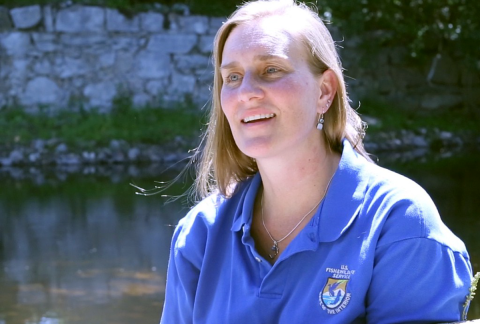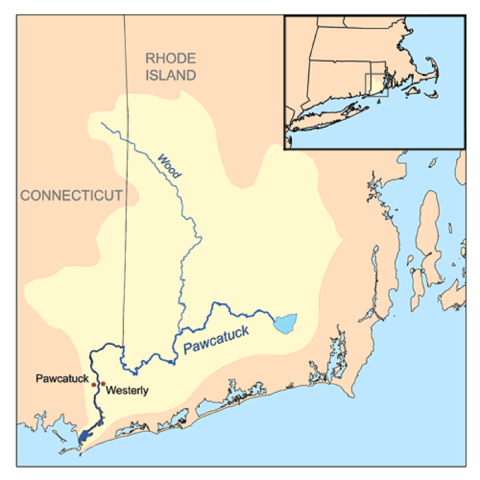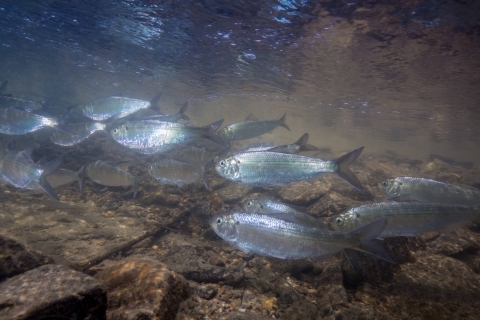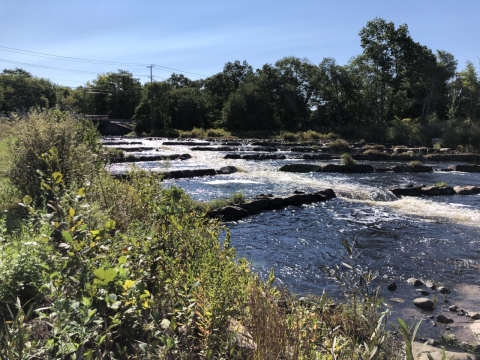Every spring for two centuries, migratory fish like alewife, blueback herring, and American shad made the 20-mile trip from Little Narragansett Bay up Rhode Island’s Pawcatuck River, over multiple barriers, only to be thwarted by six-foot-high Bradford Dam. That changed in 2019, after the obsolete dam was replaced by a nature-like fishway — rocks strategically placed in the free-flowing river to help the fish continue upstream to their historical spawning grounds.
Outliving their usefulness
Not so long ago, dams like the one at Bradford were the lifeblood of their communities, harnessing the currents of the Northeast’s rivers to power mills that produced lumber, flour, and cotton and woolen goods. Rhode Island was home to many of the early textile mills that brought the Industrial Revolution to New England, with dozens of dams built in the Wood-Pawcatuck Watershed alone.
Only a few generations have passed since the mills were in use. But today many of these dams are no longer gateways to prosperity; they have aged into perilous barriers, blocking migratory fish runs and presenting potential liabilities to the communities they once served. Many sit unattended and unmaintained, slowly collapsing into the water they once held back, while their mills have become ivy-covered relics of a bygone era.
“A lot of these dams have been in place for hundreds, sometimes 200 or even more years, and many of them had a really important function when they were first built,” said Suzanne Paton, biologist with the U.S. Fish and Wildlife Service in Rhode Island. “Now many of them are not only obsolete and not being used anymore, but they are beginning to fail. During each major storm event, the pressure of the water on them is causing them to fall apart, and so there’s a risk that having them in place will potentially lead to a catastrophic failure and impact downstream communities.”
Since 2012, Paton has worked with conservation partners like The Nature Conservancy, the Wood-Pawcatuck Watershed Association, and the Rhode Island Department of Environmental Management, pursuing the goal of returning the Pawcatuck to its natural state. Two of the dam removals — White Rock and Bradford — were supported by funding for Hurricane Sandy recovery and resilience.
A river divided
Just as serious as the risk of dam failure is the effect a divided river has on its wildlife. Once the first dams spanned the Pawcatuck in the late 1600s, fish species like blueback herring, alewife, and American shad were unable to make the journey upriver in sustainable numbers, instead becoming stranded far from their historical spawning habitat. American eel also found their path blocked as they traveled upstream as juveniles, after spawning in the Sargasso Sea.
These barriers, coupled with overfishing and chemical pollution from the old mills, drove fish populations throughout the 300-square-mile watershed dangerously low, weakening an ecosystem that stretches from its rivers all the way to the sea.
“A lot of things depend on these migrating fish species,” said Denise Poyer, who served as program director for the Wood-Pawcatuck Watershed Association for 24 years. She noted that the small fish of the Pawcatuck are a vital food source for larger fish, migratory birds, and even more species in the ocean.
“They’re a key aspect of the whole ecological foundation of the watershed,” she added.
Starting in the 1970s, conservation groups tried to aid these species through a number of means. Until the 1990s, the most common approach was to retrofit old dams with “fish ladders” – enclosed, slatted ramps with water flowing through them, basically meant as staircases for fish to swim and jump to the top of a dam. These structures were instrumental in stabilizing migratory fish populations, and a few still remain on the Pawcatuck.
While fish ladders were efficient for moving larger fish like salmon and striped bass upriver, smaller species like shad, alewife, and blueback herring – fish that, Paton points out, “don’t really jump” – still struggled to reach their spawning habitat.
Today, removing dams and restoring the river channel to a nature-like state has become the preferred method of restoring fish passage fish passage
Fish passage is the ability of fish or other aquatic species to move freely throughout their life to find food, reproduce, and complete their natural migration cycles. Millions of barriers to fish passage across the country are fragmenting habitat and leading to species declines. The U.S. Fish and Wildlife Service's National Fish Passage Program is working to reconnect watersheds to benefit both wildlife and people.
Learn more about fish passage . While more expensive than building a fish ladder, the benefits are far greater. Removing the barrier from the river completely eliminates the risk of dam failure and the need for paddlers to portage, and once it’s gone, engineers can redesign the riverbed to accommodate all the species that need to migrate upriver.
“We’re really trying to step back and look at a landscape scale,” said Paton. “Everything is connected.”
Ripple effects
From 2009 to 2022, the Service and partners removed or replaced more than 800 barriers to fish passage from Maine to West Virginia, reconnecting more than 7,700 miles of rivers and streams and 56,000 acres of wetlands. The benefits of these fish passage projects extend beyond individual watersheds.
Many of the fish species helped by river restoration are anadromous, migrating from the sea to spawn in freshwater. Much of their life is spent in the ocean, where they become food for commercial fish. A 2011 Service study found that every mile of river opened so that fish can move freely can contribute more than $500,000 in social and economic benefits once fish populations are at their full productivity. This is particularly important in states like Rhode Island, where commercial fishing and water-related recreation contribute billions of dollars to the local economy.
“By improving anadromous fish populations, we’re providing food for important species in the ocean, such as tuna, whales, and other large fish that are commercially and ecologically valuable,” said Poyer. “It’s not just the effect that it has in this watershed, but more of a global effect.”
One dam at a time
Between 2010 and 2017, seven major dams were removed from the Pawcatuck by the Service and its partners. While some, like Bradford, were replaced by nature-like rock fishways to maintain upstream water levels, others were removed entirely, returning the river to its natural flow.
In 2015, the Service joined The Nature Conservancy and Fuss and O’Neill engineering to remove the White Rock Dam, near the mouth of the river. A concrete and rock barrier much like Bradford, White Rock had also been crumbling into the river a few chunks at a time since it was breached by a storm in 1960. The flooded nearby mill race became stagnant, creating a barrier to migrating fish.
Today, however, there is little trace of a dam at the White Rock site. The concrete foundations are gone, allowing the river to flow freely and fish to pass through. The old mill race sits dry, empty, and overgrown with lush knee-high plants, shaded by trees rooted in the riverbank. The river flows by with hardly a sound.
The goal is to one day remove all the dams on the river. The ones at Potter Hill, Horseshoe Falls, and a U.S. Geological Survey gage are the only remaining obstructions. At Potter Hill, the fish ladder was repaired to improve passage in 2016, but water flowing under the old mill building on the opposite bank reduces its efficiency.
Returning to life
Even with a few projects waiting in the wings, the river has come back to life. Biologists with the Rhode Island Department of Environmental Management have recorded up to 100,000 river herring passing through the Potter Hill fishway.
Locals like David Smith, an avid paddler and wildlife enthusiast, have seen the changes in the river firsthand. Smith notes that osprey, otters, snakes, and raccoons have thrived since several of the dams were removed.
“I have been paddling the Pawcatuck River for more than 50 years,” he said. “Back in the 1960s and 1970s, the river would run red, purple, or yellow, depending on the color of dye being discharged by the mill. Now along the river I can see to the bottom and view crawfish and mussels, surely a sign that the water is clean and oxygenated.”
As a paddler, Smith has also found the new nature-like fishways to be a major improvement. Experienced paddlers are able to “run” the fishways instead of portaging around the old dams, making their passage almost as easy as it is for migrating fish.
“I will be paddling the river summer, spring, fall, and winter until someone pries the paddle from my hand,” Smith said. “Instead of looking at dams with nostalgia, I would rather see the river and the wildlife it supports endure so that my grandkids can hopefully share my love for it. That’s all the nostalgia I need.”
As dams disappear and the river flows more freely, communities along its banks are looking to the future. In 2019, after years of effort by the Wood-Pawcatuck Watershed Association and local residents, the Pawcatuck and its tributaries were added to the National Wild and Scenic Rivers Wild and Scenic Rivers
The Wild and Scenic Rivers Act of 1968 established the National Wild and Scenic Rivers System, and authorizes Congress to preserve certain rivers with outstanding natural, cultural and recreational values in a free-flowing condition for the enjoyment of present and future generations. The act is notable for safeguarding the special character of these rivers, while also recognizing the potential for their appropriate use and development. The act encourages river management that crosses political boundaries and promotes public participation in developing goals for river protection.
Learn more about Wild and Scenic Rivers System, administered by the National Park Service. Wild and Scenic designation preserves the Pawcatuck, banning new dam construction and supplying federal funds to implement a stewardship plan for the river.
“I like the river the way nature intended,” Smith said. “I understand the Industrial Revolution was necessary to our development, but like the river changes, so should our thinking. I believe future generations will thank us for advocating for the river.”
Another two centuries on, perhaps Rhode Islanders will speak of the foresight of their forebears with reverence and gratitude, as they reap the benefits of a free-flowing Pawcatuck River.







